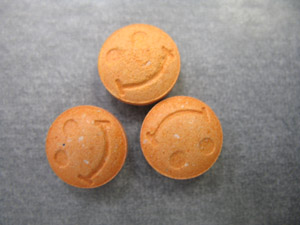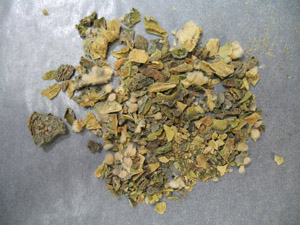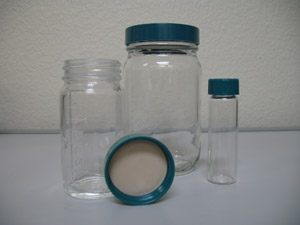Controlled Substances Section
This section performs qualitative analyses of samples for the presence of controlled substances. A wide variety of materials are encountered as samples, including powders, liquids, vegetable and plant materials, paper, and items containing residue. The most commonly encountered controlled substances are methamphetamine, marijuana, cocaine, and heroin.


Submission of Evidence
The safest guiding principle for packaging seized drug evidence is to package the items in a manner that preserves their natural order and appearance for presentation in court.
Similar items from one location, such as several bindles from the same drawer or pocket, present less confusion when packaged together. Items logically separated by space and time should be packaged separately to avoid confusion.
Describing and Marking
- Clear plastic evidence bags are recommended for inner packaging as they allow the evidence to be viewed in court without opening the bag. When sealing evidence in these bags, allow sufficient room for opening for analysis and resealing after analysis.
- Each item or package of similar items should be given a unique identifier or number.
- Each item contained in a package must be described in the listing of the package contents.
- The gross weight of the seized drug item should be recorded and listed in the item description. When seized drug evidence is packaged in glass containers, it is best to not include the glass container weighing the item.
- Clearly mark all packaging with any hazard associated with the evidence, such as biohazard, when the evidence was recovered from a body cavity or fecal matter or Fentanyl, when it is suspected.
Package Separately
- Non-controlled substance items should not be packaged with suspected controlled substances. Examples of non-controlled substance items are clothing, identification cards, compact discs, and tools.
- Pharmaceutical preparations, tablets, and capsules that do not contain a controlled substance should be packaged separately as a non-controlled substance item even if these items were recovered with the suspected controlled substance.
- Items that contain residue or are paraphernalia should be packaged separately from other seized drug evidence. These items are generally not analyzed when other seized drug evidence exists.
- Used field test kits should not be packaged with the suspected controlled substance. The Forensic Science Division does not use or need the used field test kit. If your agency requires retention of the used field test kit, package it separately and do not submit it to the Forensic Science Division.
Vegetable/Plant Material
Vegetable or plant material must be thoroughly dried prior to packaging or the material may start to mold and rot. If the plant material is recovered wet, thoroughly air dry the material at room temperature before packaging and submitting. Significant mold can form in five days or less on wet or damp plant material. After drying, the plant material should be packaged in paper or cardboard to allow breathing and further drying of the material. Roots, soil, and any other non-vegetative material should be removed before packaging plant materials.
Liquid Samples
Liquid samples should be placed in glass jars or vials that have a Teflon-lined, not paper-lined, lid.

Metal cans generally are not suitable as the primary container for liquid samples, because the cans rust which can result in leakage.
Special Circumstances
Syringes/Hypodermic devices are not analyzed unless extenuating circumstances exist, and the analysis is approved by the Division Director or designee prior to submission.
Testing Policies
The Controlled Substances section performs qualitative testing of physical substances for court and investigative purposes. Cases are prioritized based on court or investigative need first, followed by all other cases based on the date the submission was received.
Up to five different items can be submitted in a case. For cases that require analysis of more than five items, contact the district attorney’s office handling the case and the Forensic Science Division prior to submission.
Samples will be analyzed to support the highest possession or trafficking charge. When multiple samples likely to contain a Schedule I compound are submitted, one of each type of substance will be analyzed. When a Schedule I compound is identified, substances likely to contain a compound with a lower schedule will not be analyzed.
Items containing residue only and/or paraphernalia items will only be tested when no other controlled substance evidence exists, other items do not contain a controlled substance, or at a special request for the district attorney’s office handling the case.
General Information
The laboratory does not quantitate cannabis for percent THC. Our analytical process will provide an indication of marijuana or hemp
Limited analytical services are provided in clandestine laboratory cases. The provided services include analysis and identification of precursors, such as ephedrine or pseudoephedrine, and controlled end-products, such as methamphetamine. No analytical or testimonial services are provided for manufacturing methods, by-products, or other starting materials. Before submitting any evidence from a clandestine laboratory, please contact the Forensic Science Division to discuss the case. Also, consultation with the District Attorney handling the case is an integral part of a clandestine laboratory case.
Limited analytical services are provided for the analysis of suspected steroids in seized drug cases. The Forensic Science Division does not have many of the reference materials for steroid compounds; thus, confirmation of steroid compounds may not be made.
The laboratory does not test paper currency for the presence of controlled substances.
Methods
The following examinations or tests may be employed in seized drug analyses:
Macroscopic (i.e., visual) examinationsMicroscopic examinations
Weight measurements
Screening (i.e., presumptive) tests, including color tests
Extraction, separation, and concentration techniques
Fourier transform infrared spectroscopy (FTIR)
Gas chromatography/mass spectrometry (GC/MS)
Gas chromatography/infrared spectrometry (GC-IR)
